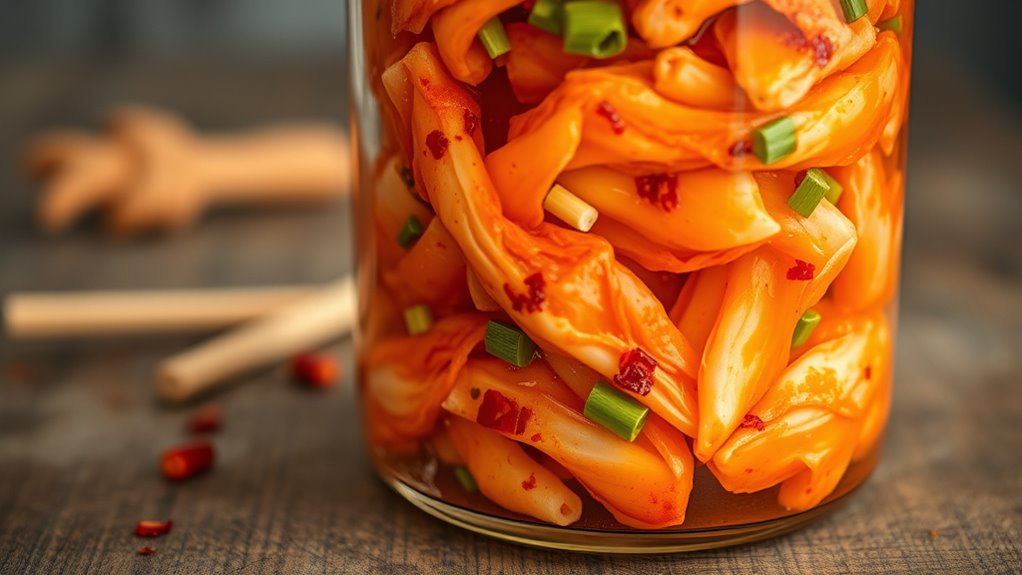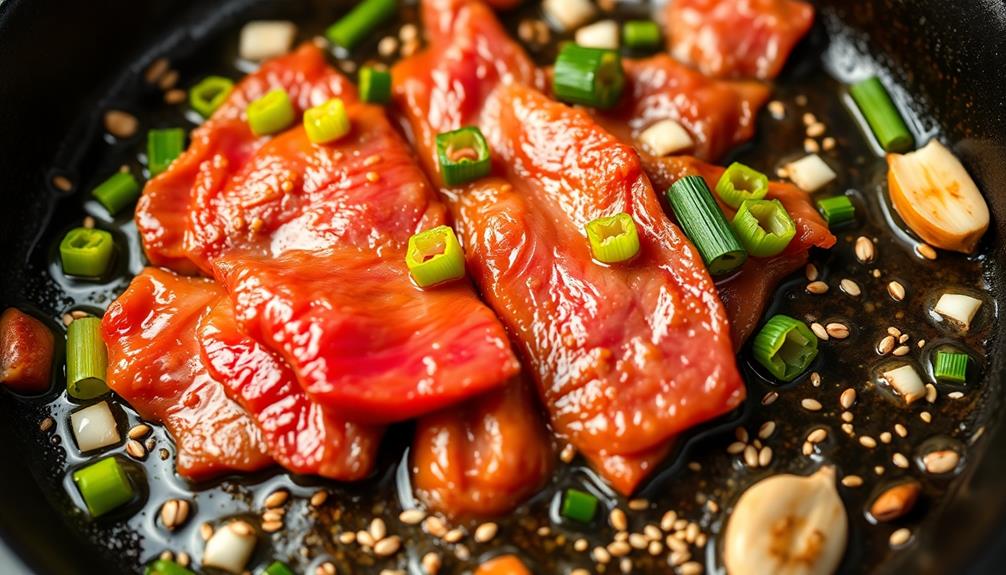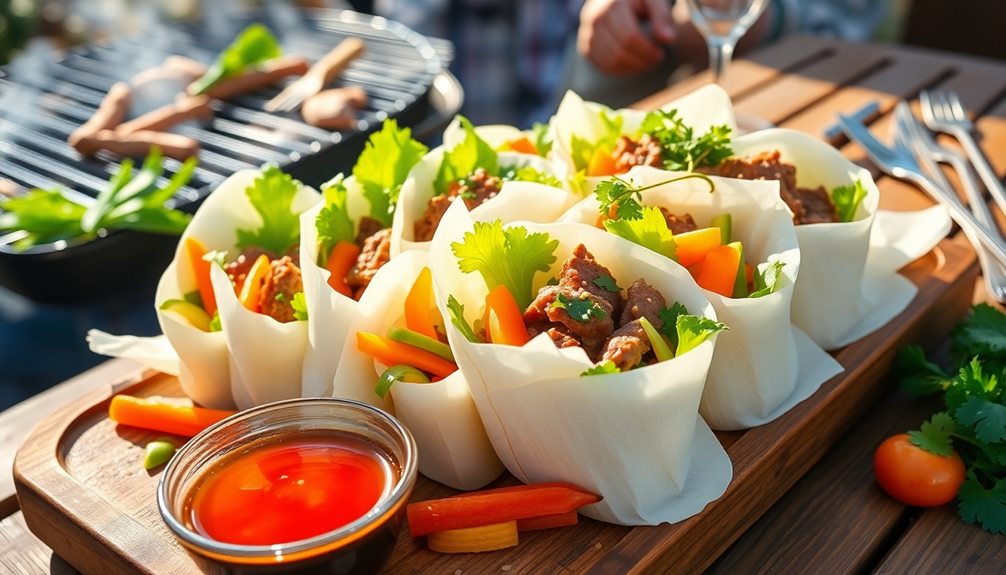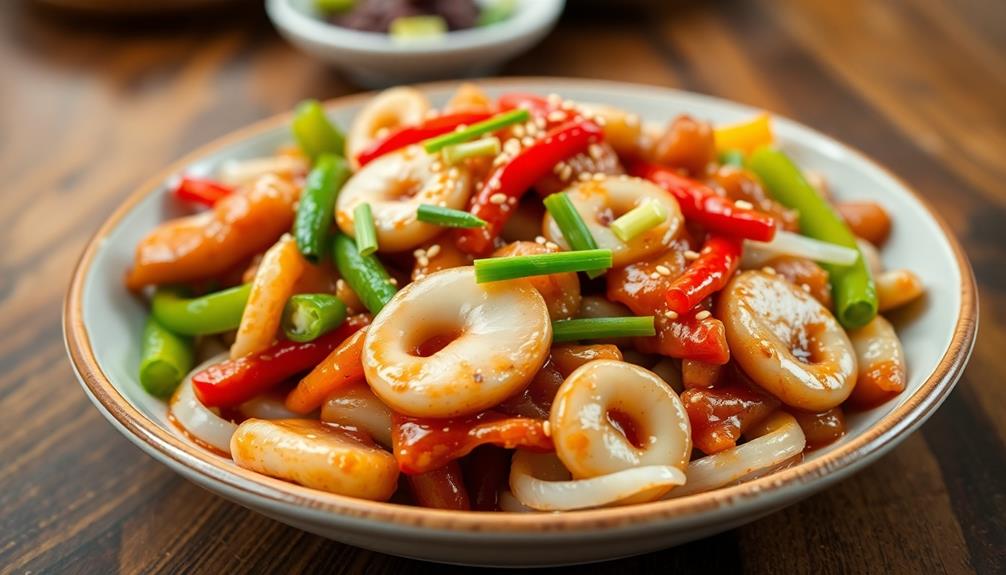To determine when homemade kimchi is safest to eat, monitor its pH curve. Typically, initial pH starts around 6.0-6.5, then drops as fermentation progresses. Once the pH stabilizes below 4.6 and remains steady for several days, your kimchi is usually safe and ready. Waiting until this stage guarantees harmful bacteria are inhibited. If you want to understand how to track this process more precisely, there’s more to learn about pH and fermentation cues.
Key Takeaways
- Kimchi becomes safest to eat once pH stabilizes below 4.6, typically after several days of fermentation.
- Monitoring pH helps determine when acidity is sufficient to inhibit harmful bacteria.
- A steady, low pH indicates successful fermentation and safe consumption; rising pH suggests spoilage risks.
- Proper temperature control ensures consistent pH decline and stability for safe kimchi.
- Regular pH measurements provide a reliable indicator of optimal, safe eating time during fermentation.
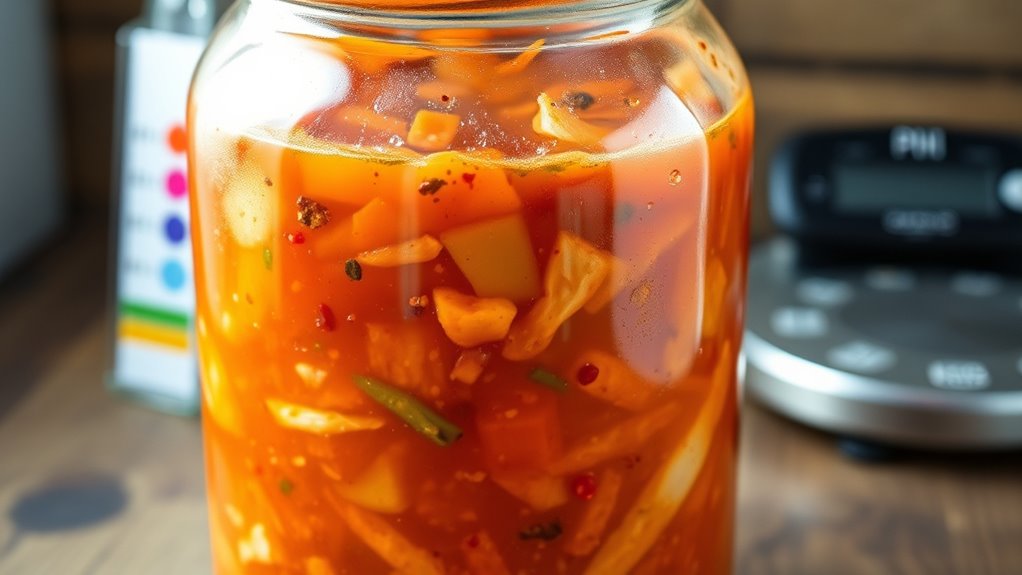
Making homemade kimchi involves more than just fermentation; tracking its pH over time reveals the complex process of acidification. When you carefully monitor the pH curve, you gain insight into the safety and quality of your kimchi. Fermentation safety hinges on reaching the right acidity level, which prevents harmful bacteria from thriving. As lactic acid bacteria ferment the sugars in your vegetables, the pH drops, creating an environment that inhibits pathogens like Salmonella or Clostridium botulinum. This acidification is vital for making your kimchi safe to eat, but it also requires maintaining pH stability throughout the process.
Understanding the pH curve helps you determine the ideal window for consumption. Typically, fresh kimchi starts with a pH around 6.0 to 6.5, which is too high for safe eating. As fermentation progresses, the pH steadily drops, often reaching about 4.2 to 4.5 within a few days to a week, depending on temperature and ingredients. Once the pH stabilizes below 4.6, it indicates that the environment is sufficiently acidic to inhibit most pathogens. Waiting until this point guarantees your kimchi has achieved fermentation safety, reducing the risk of foodborne illness.
However, pH stability isn’t just about reaching a low level; it’s about maintaining that acidity consistently over time. If the pH begins to rise again after reaching its lowest point, it might signal spoilage or improper fermentation conditions. Temperature control during fermentation plays a vital role here. Keeping your kimchi at an ideal temperature—around 65-70°F (18-21°C)—promotes steady acidification and pH stability. Too warm and fermentation could accelerate unevenly, risking over-fermentation or spoilage, while too cold might slow down the process, delaying safety. Additionally, understanding the role of color accuracy in fermentation can help you visually assess the progress of your kimchi. Proper temperature management not only influences pH but also impacts the appearance and texture of your kimchi, ensuring a better final product.
Paying attention to your pH measurements throughout fermentation helps you identify when it’s safest to eat. Once the pH remains stable below 4.6 for several days, you can confidently enjoy your kimchi. This stability indicates that fermentation has completed, and the environment is hostile to undesirable bacteria. Remember, tasting alone isn’t enough; measuring the pH provides a precise and reliable indicator of safety. By monitoring the pH stability and ensuring pH stability, you’re taking control of the fermentation process, making your homemade kimchi both delicious and safe for everyday consumption. Additionally, understanding fermentation timing can help you better plan your fermentation schedule for optimal safety and flavor.
Frequently Asked Questions
How Long Does It Take for Kimchi to Reach the Safe Ph Level?
You wonder how long it takes for kimchi to reach a safe pH level. Typically, during fermentation, the timeline varies depending on ingredients and temperature, but it generally takes about 3 to 7 days. Using pH measurement techniques helps you monitor this process accurately. Once the pH drops below 4.6, you can be confident that the kimchi is safe to eat, ensuring proper fermentation and acidity levels.
Can Homemade Kimchi Become Unsafe if Stored Too Long?
You might wonder if homemade kimchi becomes unsafe if stored too long. Over time, fermentation duration can lead to spoilage signs like an off smell, sliminess, or mold. If you notice these signs, it’s best to discard it. Proper storage in the fridge slows fermentation, but don’t ignore spoilage indicators. Always trust your senses to determine if your kimchi is still safe to eat after extended storage.
What Ph Level Indicates Kimchi Is Still Fermenting?
You’re wondering if your kimchi is still fermenting, right? The key lies in its pH level—if it’s between 4.2 and 4.6, fermentation is actively happening. During the fermentation timeline, microbial activity is at its peak, creating that delicious tang. Keep an eye on the pH; as it drops below 4.2, fermentation slows, and your kimchi becomes more stable. So, monitor the pH to enjoy it at its best!
Does Temperature Affect the Ph Curve of Kimchi?
Temperature definitely impacts the pH curve of your kimchi. When fermentation temperature rises, the bacteria work faster, causing the pH to drop more quickly. Conversely, cooler storage environments slow down fermentation, leading to a more gradual pH change. Keeping your kimchi at a consistent, ideal temperature guarantees steady fermentation and safe eating, preventing over-fermentation or spoilage. Adjusting fermentation temperature based on your storage environment helps you control the process effectively.
Is There a Visual Cue to Determine Kimchi’S Safety Apart From Ph?
You can look for visual cues and aroma indicators to determine if your kimchi is safe to eat. If it develops mold, sliminess, or an off-putting smell, it’s best to discard it. Fresh kimchi should look vibrant and smell tangy but pleasant. Trust these visual cues and aroma indicators over other signs—if anything seems unusual, it’s safer to avoid eating it to prevent potential health issues.
Conclusion
Knowing when your homemade kimchi is safe to eat is key to enjoying its flavors without risk. Typically, the pH drops below 4.0 within a week, making it safe for most people. Did you know that during fermentation, kimchi’s pH can decrease from about 5.0 to under 4.0 in just five days? So, trust the pH curve—wait until it hits that safe zone before digging in, and you’ll savor your kimchi worry-free.
